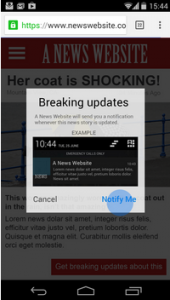Why is asking for permission to send chrome push notifications so important?
Web push notifications can be sent to a user only when you have his permission. In Chrome, if a user denies a website access to permission, the site will never be able to ask for the permission to that user again. Chrome is even planning to automatically deny permission prompts from websites whose prompts are largely ignored or dismissed by users. So, it becomes all the more important to show the permission prompt and ask for user’s permission at the right time.
Best Practices: When & How to ask for user’s permission:
- The user should show intent
Ask for user’s permission only when he is willing to grant permission. So instead of showing the permission prompt directly, it would be better to ask for user’s intent first. For e.g The user should be asked if he would like to give permission to the site to send him regular updates/notifications. If he dismisses, he shouldn’t be asked for permission. If he allows, then only he should be shown the permission prompt.
- The user should have spent some time on your site and know about your product
Google strongly recommends against showing permission prompt immediately after a user lands on a website. User should be asked for permission only when he has a fairly good idea of what the site is about.
- The user should know for what is he giving permission
While asking for permission, context should be set and user should know what kind of notifications he will be getting. For e.g Before asking for permission, an e commerce website should ask the user if he would like to get updates on special offers. Here, the user knows what kind of updates he will be getting after granting permission.
- Websites should provide the users with controls to manage their notification preferences
Google recommends that the websites provide the users with settings to subscribe/ unsubscribe from notifications of a particular type/ category. For e.g A user might be interested in getting updates on Sports news but is annoyed by updates on movies. So, the news website should provide the user with an option to subscribe specifically to updates on Sports.This could actually prove beneficial as:
- The user will unsubscribe from a specific category only and will not be forced to revoke his permission to stop the website from sending him any type of notifications.
- In future, the user may decide to get other types of updates as well from the website and turn them on.
Metrics to be measured:
It is important to measure the acceptance rates of permission prompts and also to keep a track of the no. of users who revoke permission.
If you show permission prompt to only those users who show the intent to grant permission, you should measure:
- How many users clicked “Allow” on the first opt-in pop up and showed intent to grant permission
- How many users clicked “Deny” on the first opt-in pop up and did not show intent to grant permission
- How many users ignored/ closed the first opt-in pop up
- How many of the users who clicked “Allow” on first opt-in pop up granted permission when the permission prompt was shown
- How many of the users who clicked “Allow” on first opt-in pop up did not grant permission when the permission prompt was shown
- How many of the users who had earlier granted permission revoked it later
If you show permission prompt immediately without asking for user intent, measure:
- How many users clicked “Allow” on the permission prompt and granted permission
- How many users clicked “Deny” on the permission prompt and denied permission
- How many users ignored/ closed the permission prompt
- How many of the users who had earlier granted permission revoked it later


